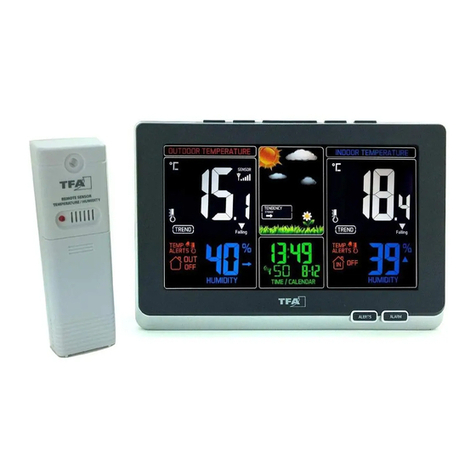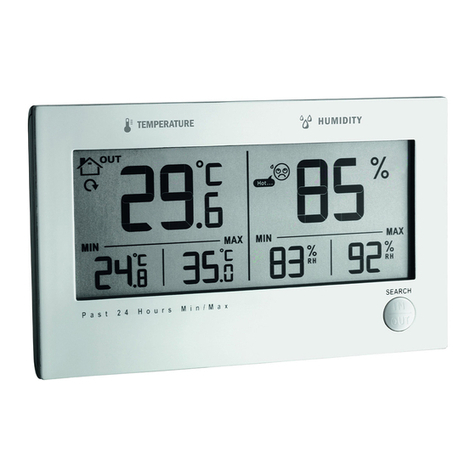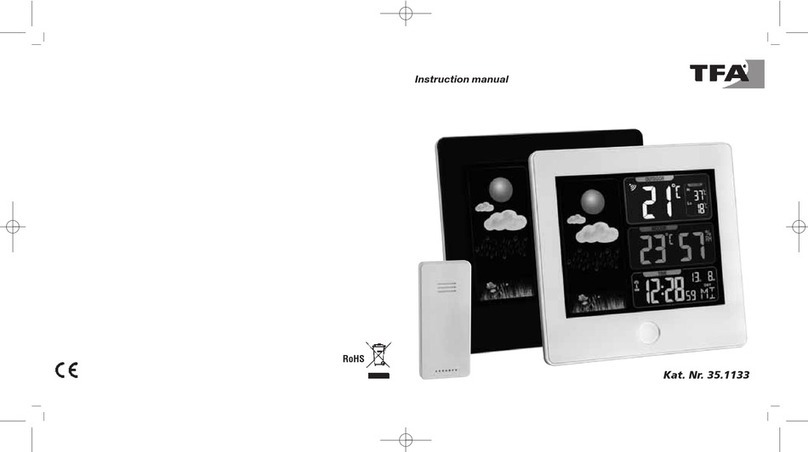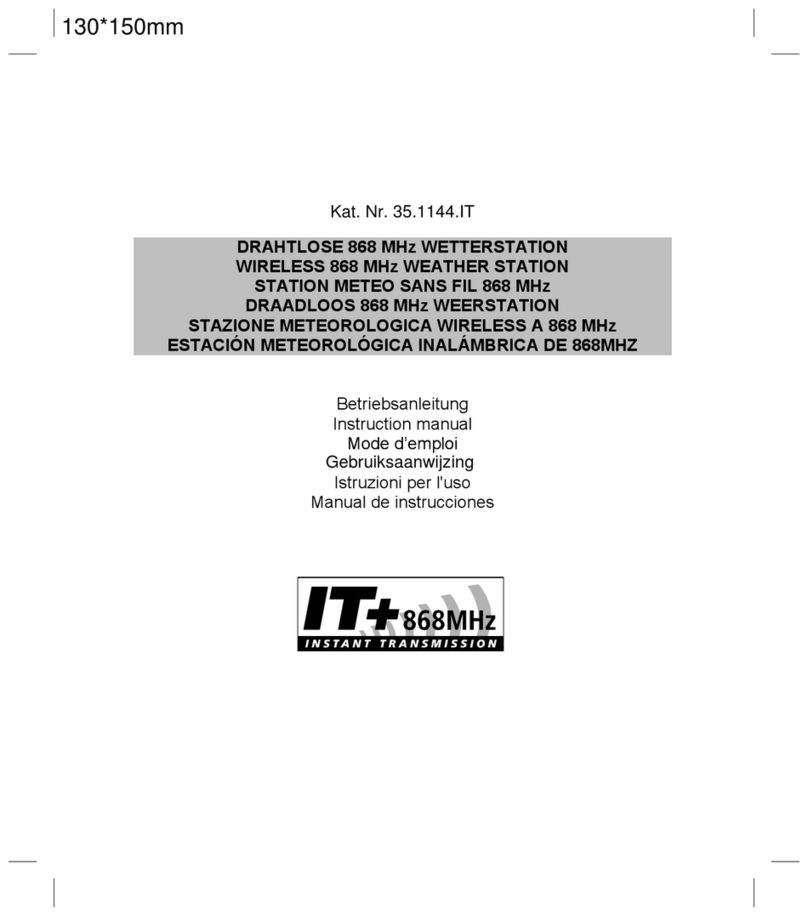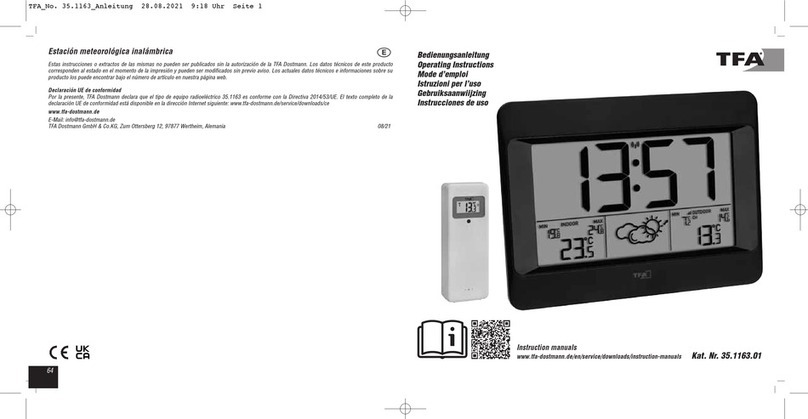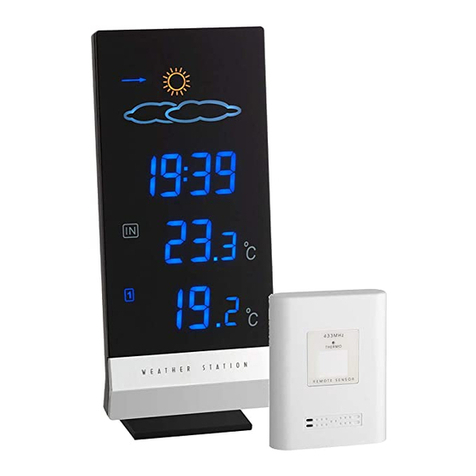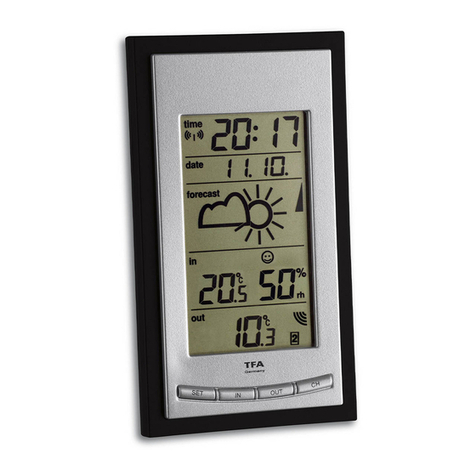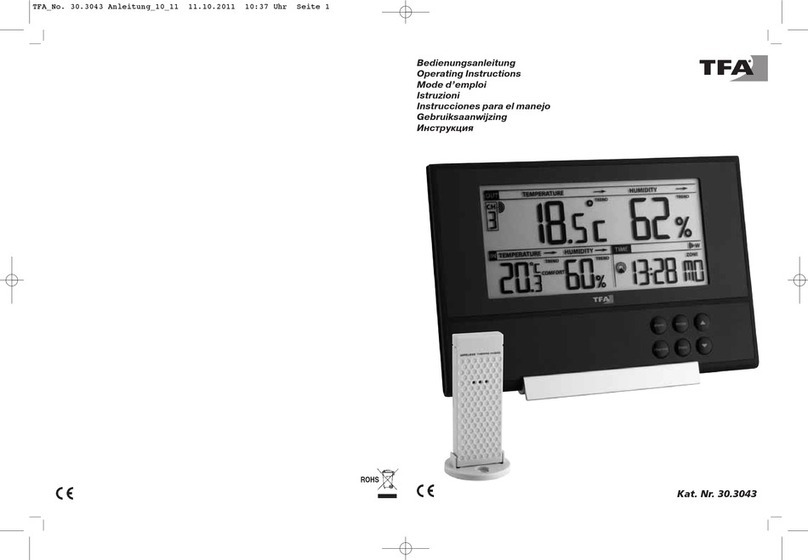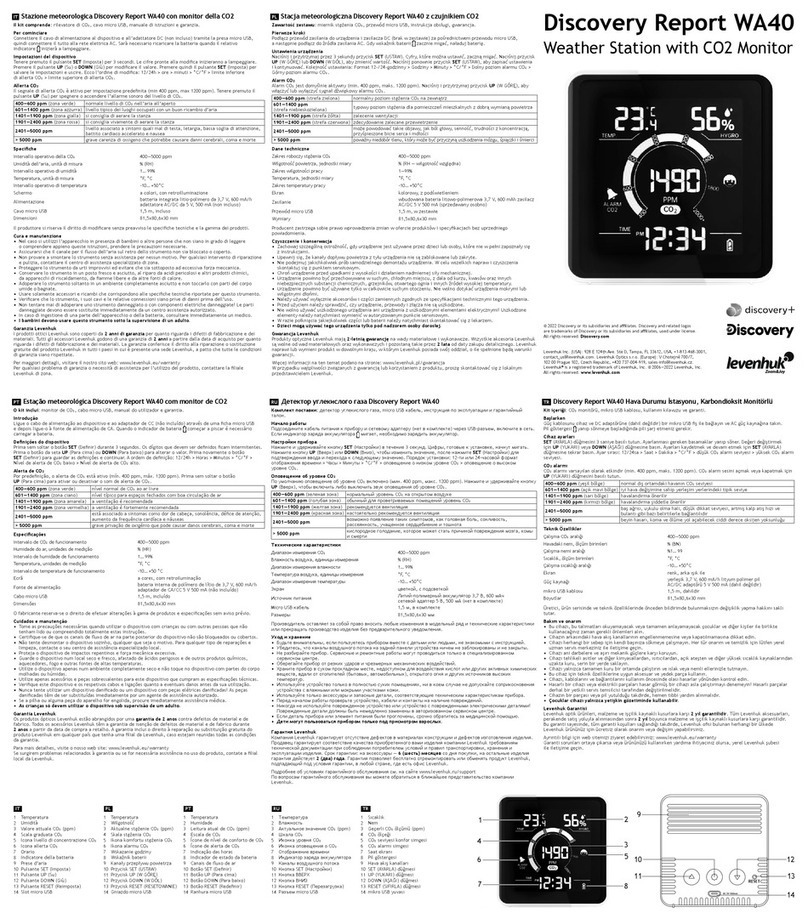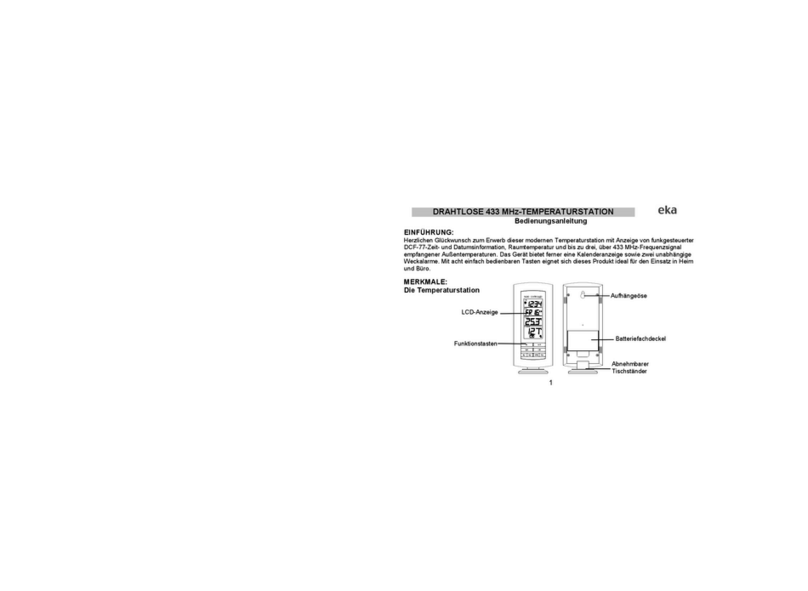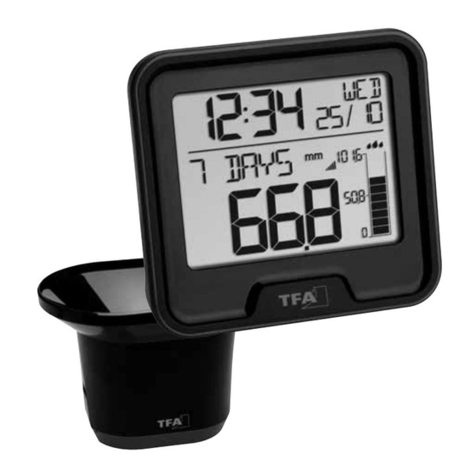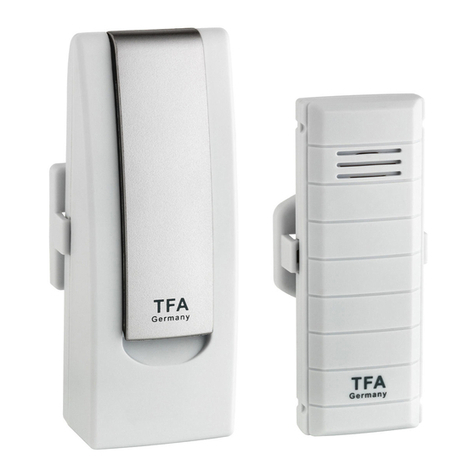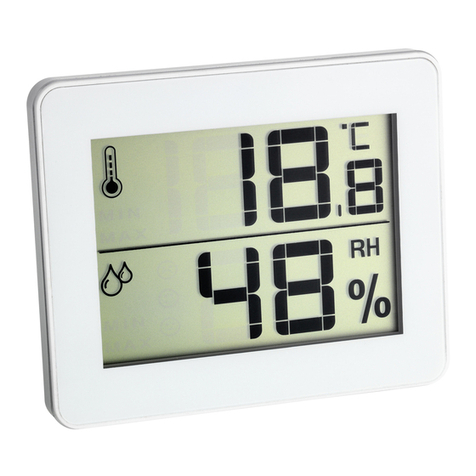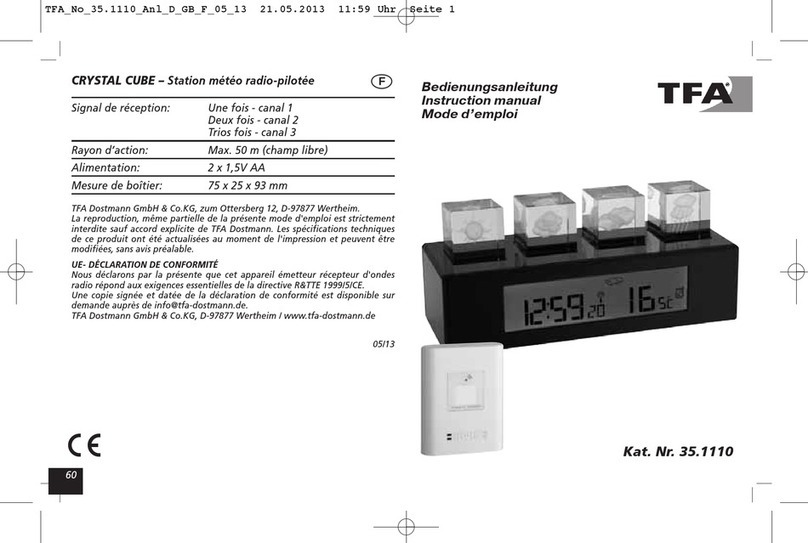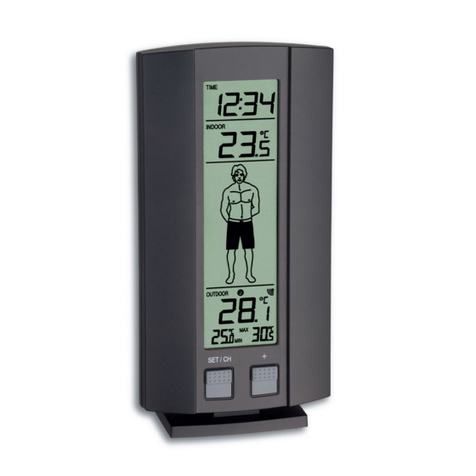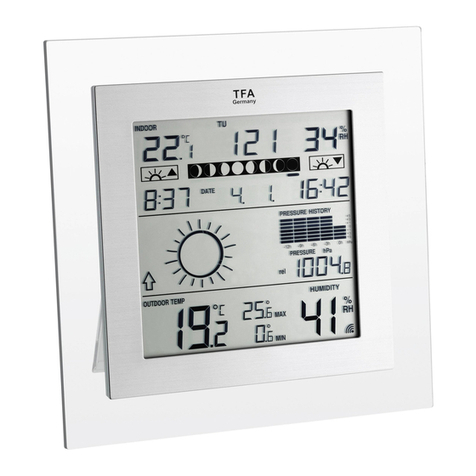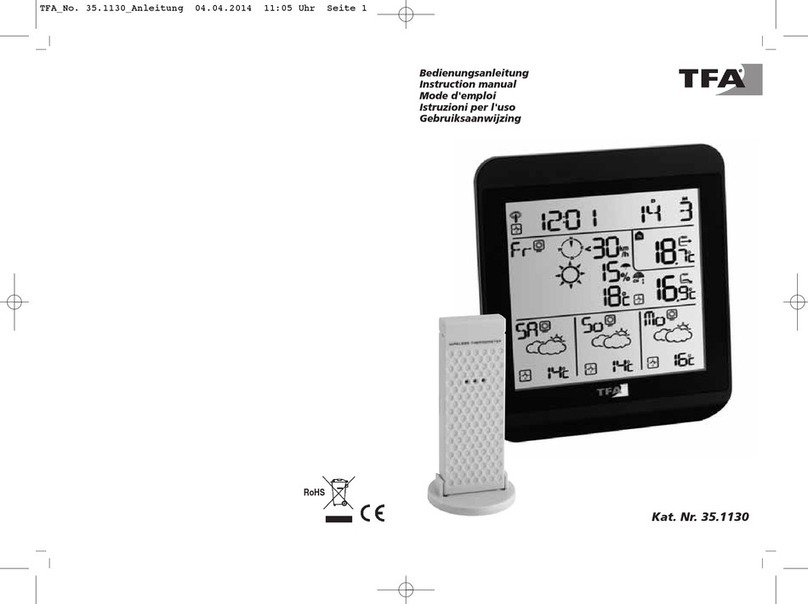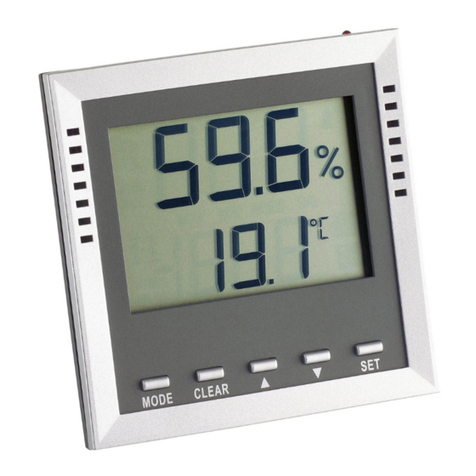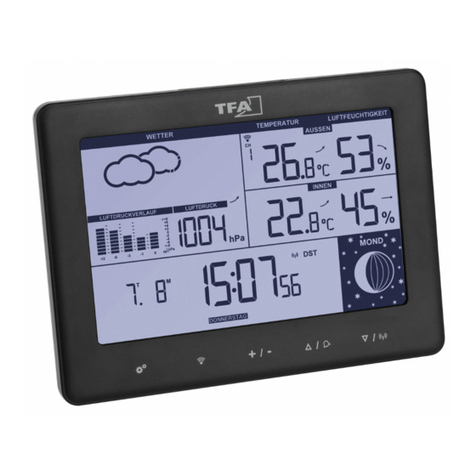1110
SEASON – Funk-Wetterstation
6.4 Hinweis zum Empfang der Funkzeit
Die Zeitübertragung erfolgt von einer Cäsium Atom-Funkuhr, die von der Physikalisch Technischen Bundesanstalt in Braun-
schweig betrieben wird. Die Abweichung beträgt weniger als 1 Sekunde in einer Million Jahren. Die Zeit ist kodiert und wird
von Mainflingen in der Nähe von Frankfurt am Main durch ein DCF-77 (77.5 kHz) Frequenzsignal übertragen mit einer Reich-
weite von ca. 1.500 km. Ihre Funkuhr empfängt das Signal, wandelt es um und zeigt immer die exakte Zeit an. Auch die
Umstellung von Sommer- und Winterzeit erfolgt automatisch. Während der Sommerzeit erscheint DST auf dem Display. Der
Empfang hängt hauptsächlich von der geographischen Lage ab. Im Normalfall sollten innerhalb des Radius von 1.500 km
ausgehend von Frankfurt bei der Übertragung keine Probleme auftauchen.
Bitte beachten Sie folgende Hinweise:
• Es wird empfohlen, einen Abstand von mindestens 1,5 – 2 Metern zu eventuell störenden Geräten wie Computerbildschirmen
und Fernsehgeräten einzuhalten.
• In Stahlbetonbauten (Kellern, Aufbauten) ist das empfangene Signal natürlicherweise schwächer. In Extremfällen wird emp-
fohlen, das Gerät in Fensternähe zu platzieren und/oder durch Drehen das Funksignal besser zu empfangen.
• Nachts sind die atmosphärischen Störungen meist geringer und ein Empfang ist in den meisten Fällen möglich. Ein einziger
Empfang pro Tag genügt, um die Genauigkeit zu gewährleisten und Abweichungen unter 1 Sekunde zu halten.
7. Hintergrundbeleuchtung
•Achtung: Die Hintergrundbeleuchtung im Dauerbetrieb funktioniert nur mit Netzstecker.
• Voreinstellung für die Hintergrundbeleuchtung ist HI.
• Drücken Sie die LIGHT (HI – LOW - OFF) Taste einmal (LOW), um die Hintergrundbeleuchtung zu dimmen.
• Drücken Sie die LIGHT (HI – LOW - OFF) Taste noch einmal (OFF), um die Hintergrundbeleuchtung auszuschalten.
• Zum kurzzeitigen Aktivieren der Hintergrundbeleuchtung drücken Sie eine beliebige Taste (nur im Batteriebetrieb).
8. Bedienung
• Drücken Sie die LIGHT Taste, um den Einstellmodus zu verlassen. Das Gerät verlässt automatisch den Einstellmodus, wenn
für längere Zeit keine Taste gedrückt wird.
• Halten Sie die + oder – Taste im Einstellmodus gedrückt, gelangen Sie in den Schnelllauf.
SEASON – Funk-Wetterstation
8.1 Manuelle Einstellungen
• Halten Sie die SET Taste im Normalmodus für drei Sekunden gedrückt, um in den Einstellmodus zu gelangen:
• DEUTSCH (Voreinstellung) blinkt im Display.
• Mit der + oder – Taste können Sie die Spracheinstellung für die Wochentage auswählen.
• Haben Sie Deutsch ausgewählt, erscheint die Anzeige nun auf Deutsch.
• Drücken Sie die SET Taste noch einmal und Sie können nun nacheinander die Tastentöne (Voreinstellung PIEP ON), den
DCF Empfang (Voreinstellung: DCF ON), die Zeitzone (Voreinstellung: DCF 00H), das 12- oder 24-Stunden-Zeitsystem
(Voreinstellung: FORMAT 24Hr), die Stunden, die Minuten, das Jahr, den Monat, den Tag, die Temperatureinheit (Vor-
einstellung: TEMP °C), die Luftdruckanzeige (Voreinstellung: L-DRUCK HPA) und den Luftdruckwert (Voreinstellung:
1013 hPa) ansteuern und mit der + oder –Taste einstellen.
• Bestätigen Sie die Eingabe mit der SET Taste.
• Bei erfolgreichem Empfang des DCF-Funksignals und bei aktiviertem Empfang (DCF ON) wird die manuell eingestellte Zeit
überschrieben.
8.1.1 Einstellung der Sprachauswahl für den Wochentag
• Im Einstellungsmodus können Sie die Sprache für den Wochentag auswählen.
• Drücken Sie die + oder –Taste.
• Im Display erscheint: Deutsch - DEUTSCH, Französisch - FRANCAIS, Italienisch - ITALIANO, Spanisch – ESPANOL, Nieder-
ländisch – NEDERLANDS und Englisch - ENGLISH.
8.1.2 Tastentöne
• Im Einstellungsmodus können Sie mit der + oder –Taste die Tastentöne aktivieren oder deaktivieren.
8.1.3 DCF-Funkempfang
• Standardgemäß ist der DCF-Empfang aktiviert (DCF ON) und nach erfolgreichem Empfang des DCF-Funksignals ist keine
manuelle Einstellung erforderlich.
• Drücken Sie im Einstellungsmodus die + oder – Taste, wenn Sie den DCF-Funkempfang deaktivieren wollen (DCF OFF).
• Bei deaktiviertem Empfang müssen Sie Uhrzeit und Datum manuell einstellen. Es erscheint keine Zeitzone.
TFA_No. 35.1150_Anleitung 21.09.2018 10:15 Uhr Seite 6
